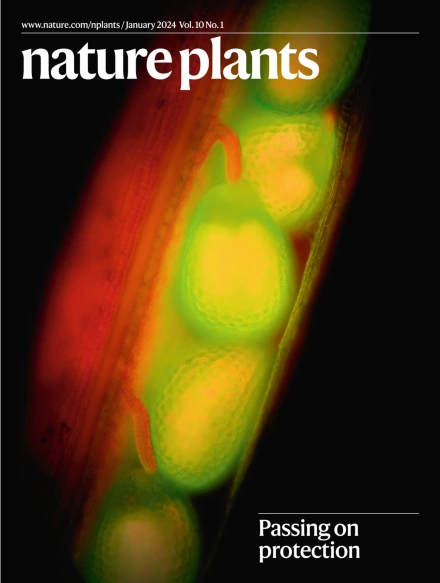Plastids affect embryo patterning
IF 15.8
1区 生物学
Q1 PLANT SCIENCES
引用次数: 0

质体影响胚胎形态
质体对植物细胞至关重要,是胚胎发生过程中的生化枢纽。因此,许多编码质体靶向蛋白的基因敲除突变体在拟南芥中是胚胎致死的。然而,到目前为止,这种胚胎致死表型的原因被认为与普遍缺乏必需的质体生成的代谢物(如脂质或氨基酸)有关。人们对质体在胚胎发生过程中的潜在特殊作用知之甚少。GENOMES UNCOUPLED 1(GUN1)和 DELAYED GREENING 1(DG1)是质体定位蛋白,与多器官 RNA 编辑因子 2(MORF2)结合后参与 RNA 编辑。然而,至少对 GUN1 而言,已知其在逆行信号中的神秘作用是影响核基因表达以响应质体信号。研究人员发现了一种隐性 dg1 突变体,该突变体会导致杂合子植株四分之一的后代--推测是同合子胚胎--在球形期胚胎停育。通常局限于子叶间区的 WUS 和 STM 的表达在这些突变体中扩大,维管特性没有达到子叶初生区。在野生型胚胎中,DG1 除了在初生的嫩枝顶端分生组织中广泛表达外,在其他部位也广泛表达,这与 DG1 抑制 WUS 和 STM 的观点一致。DG1 的这一作用与它与 MORF2 的相互作用无关,因此也与质体 RNA 编辑无关,质体 RNA 编辑依赖于 MORF2 的相互作用。相反,dg1 胚胎的缺陷被 gun1 突变体部分抑制,双突变体可发育到鱼雷期,并显示 WUS 和 STM 的正常表达。这些结果表明,WUS 和 STM 的表达受到质粒逆行信号的影响,而质粒逆行信号有助于胚胎形态的形成。
本文章由计算机程序翻译,如有差异,请以英文原文为准。
求助全文
约1分钟内获得全文
求助全文
来源期刊

Nature Plants
PLANT SCIENCES-
CiteScore
25.30
自引率
2.20%
发文量
196
期刊介绍:
Nature Plants is an online-only, monthly journal publishing the best research on plants — from their evolution, development, metabolism and environmental interactions to their societal significance.
 求助内容:
求助内容: 应助结果提醒方式:
应助结果提醒方式:


